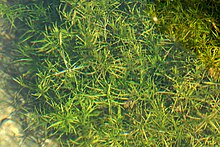en
names in breadcrumbs


Callitriche hamulata is a species of flowering plant belonging to the family Plantaginaceae.[2]
It is a submerged plant with slender, branching stems about 20–70 cm (8–28 in) long. The light green, narrow leaves are up to 6 cm (2 in) long and 1-2mm wide, slightly broadening at the tip. The leaves which can float on top of the water, are shorter and wider, they are also light brownish or pinkish green.[3] It has tiny inconspicuous green flowers and fruits,[4] and has a flowering period of between May and October.[5] or between April and September in the UK.[4]

It was then described by Wilhelm Daniel Joseph Koch before being widely published by Friedrich Traugott Kützing in 'Synopsis Florae Germanicae et Helveticae' Collection 246 in 1837.[1][6]
The Latin specific epithet hamulata is derived from hamatus meaning "with hooks" or "hooked",[7] referring to the hooked end of the leaves.[5]

Callitriche hamulata is native to a wide area, which stretches from Greenland,[2][8] and Iceland,[3] through Europe to North-western Africa.[2]
It is widespread and fairly frequent in Britain, particularly in south eastern England.[4]
It is found in rapidly flowing streams,[9] which are well oxygenated, and freshwaters, from sea level to about 1,200 m (3,900 ft) above sea level.[5] This plant can grow in shallow waters and can also adapt to a deeper water level, especially after flooding.[3] It can also be found in or near ponds, ditches, in still or slow moving water.[4]
Callitriche hamulata is a species of flowering plant belonging to the family Plantaginaceae.